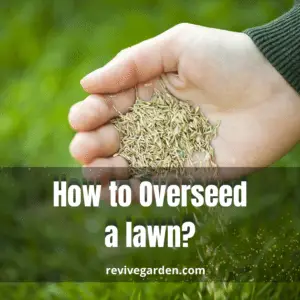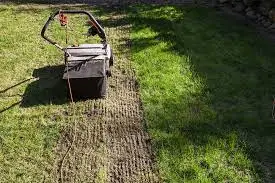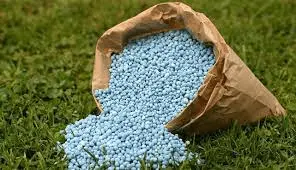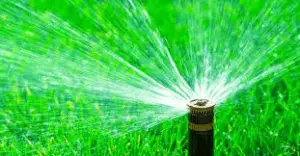Table of Contents

The trick to getting gorgeous, lush grass exists. Many homeowners are unaware of it, but landscape experts are. Lawns look lovely as long as overseeding is done as part of an all-encompassing, proactive approach. Learning how to overseed your lawn will help you get better outcomes whether you’re taking care of your first lawn or have years of experience. We are here to provide you with an ultimate guide on How to Overseed a lawn?
We hope this article will prove itself adequate for your information about lawn overseeding.
What is Overseeding?
Overseeding is the procedure of spreading grass seed onto an already established lawn. It’s an uncomplicated process with tangible outcomes when carried out correctly. Thinning is common as grasses get older, especially if you like and use your lawn frequently. Overseeding keeps your grass competitive and infused with life and vigor without starting from scratch.
Best Time for Overseeding Lawns
The seeds you are planting will determine when to overseed your grass. In northern regions, overseeding should be done 45 days before the first frost in the planting zone. This is the best way to strengthen a thinned-out or soft grass. The optimal time to enhance turf in the spring is after all freeze threats have gone through the area. It should overseed warm-season grasses to produce winter color in southern areas after nighttime lows fall below 65 degrees. To encourage germination under high soil temperatures, thoroughly prepare the area beforehand.
Process of Overseeding
While the fundamentals of Overseeding are universal, the objectives and timing differ by region and grass variety. Follow this simple advice for grass Overseeding success:
- Pick a Good Grass Seed Product
- Dethatch the lawn
- Mow the Lawn
- Add Enriched Topsoil
- Distribute the grass seed.
- Add fertilizers.
- Water your lawn regularly.
Step 1: Choose the appropriate lawn seed.
Selecting the proper seed for overseeding is crucial. Try to identify the varieties of grass already present on your lawn first. You should also consider how you utilize the grass, the garden’s aspect if the soil drains effectively, and the appearance you want to create.
You might need to use a different seed mixture for various parts of your yard or even the same lawn. The seeds must be able to get to the soil for new grass to develop. Before applying the source, your grass can benefit from dethatching and aeration. Although not necessary, this process will result in better seed germination.
Step 2: Dethatch the lawn

If the thatch in your yard is so thick that you cannot see the soil beneath it, you should first dethatch the lawn. Use a core aerator to aerate the grass after dethatching by making holes in the ground. You must do it now if you haven’t aerated in the previous 12 months.
Step 3: Rake and mow the lawn.
Getting grass seed in contact with the soil is the aim of overseeding a lawn. The first step in doing that is to mow the lawn. Cut it shorter than usual to increase the likelihood that the grass seed will make it to the soil. To prevent the cuttings between the roots and soil, make sure to bag them.
Rake the entire lawn after mowing to eliminate any debris, including dead grass, rocks, and sticks. This procedure prepares the soil for sowing and germination by removing any remaining barriers between the grass seed and the earth.

Step 4: Add Enriched Topsoil
Enriched topsoil is a compost and soil mixture rich in nutrients that will aid new grass’s faster and thicker growth. Apply a topsoil layer about 1/4 inch thick over your current grass using a fertilizer spreader.
Note that some seed combinations for grass already contain topsoil. You can proceed directly to dispersing the seed if you’re using one of these combinations; skip this step.
Step 5: Distribute the grass seed
Start by placing the grass seed into a seed spreader and spreading around 16 germs per square inch of soil at the proper time to overseed. Some properties may require less seed than others, depending on the thickness of the current property. If you don’t have a spreader, you can distribute grass seeds by hand.
Select a grass seed that blends in with the current grass and is adapted to your climate or region. For extreme temperatures like those in the Northeast and Pacific Northwest, lawns with cool-season grasses flourish. Warm-season grasses thrive when living in a hot climate area, such as the southern United States.
Step 6: Distribute the fertilizers
Pre-emergent herbicides in weed and feed products prevent seed germination. Starter fertilizers deliver vital nutrients for new grass. While nitrogen promotes top growth and greening, phosphorus helps strong root growth. Due to environmental concerns about runoff, phosphorus lawn fertilizers are restricted in several states and counties; however, new seedings may be an exception. If you want to know how much fertilizer you can use, you should talk to the county extension agent.

Step7: Water your lawn
Keep watering the grass until the new growth is the same length as the old, and ensure the seeds and soil are continually moist by watering once or twice daily. After that, rinse your grass to prevent wilting and develop a robust, deep root system. Wait to mow the lawn until it has filled in and the grass is at least an inch tall.
A healthy lawn requires a lot of water to thrive, but once your grass is established and thriving, you may reduce your usage and minimize your monthly costs by following this water-saving advice.

Reasons to Overseed Your Lawn
If done correctly, overseeding has no drawbacks and offers your grass several advantages.
Pros of Overseeding
- Covers up bare and thin regions (or prevents them if you act early enough)
- Promotes thicker grass growth
- Increases the lawn’s resistance to drought, heat, illnesses, bugs, and other problems.
- Aids turfgrass in displacing weeds
- Keeps your lawn lush all winter long (when you overseed with ryegrass in fall)
Final Reflections
The purpose of the article was to highlight the information about when and how to overseed a lawn. A complete guide is provided in the article about overseeding, its procedures, and the use of the equipment for the overseeding process.
